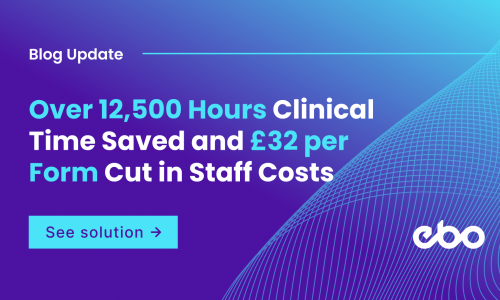With new NHS investment unlocking the potential of patient portals across mental health and community trusts, EBO convened a roundtable of healthcare leaders, AI experts, and clinicians to explore:
- How patient portal design is evolving to truly meet the needs of mental health service users – with empathy, accessibility, and inclusivity at its core.
- How AI and behavioural science are reshaping portals to provide a more personalised, responsive mental health support and a meaningful patient experience.

Aimed at Rio EPR users, the session also offered a live showcase of EBO’s latest Intelligent Patient Portal, demonstrating its seamless integration into both the NHS App and the Rio EPR system.
Moderated by Simon Hepworth, EBO’s Head of Customer Success, the roundtable featured an expert panel including:
- Richard Samuel, Director of Healthcare Strategy at EBO and former NHS England Director and Chief Executive
- Sharon Price, Clinical Pre-Sales Manager, EBO
- John Deguara, Chief Technology Officer, EBO
- David Pike, Assistant Director of Healthcare Informatics – Clinical Systems, NELFT
- Samir Shah, Chief Clinical Information Officer, NELFT
The session opened with a keynote from Richard Samuel, who reflected on lessons learned from leading the national rollout of patient portals across the NHS and shared a compelling vision for how we can do it better in mental health and community care.
Here are the key takeaways.
1. Full EPR Integration Is Non-Negotiable
Richard urged commissioners to resist the temptation to copy-paste portal solutions from acute care settings. His first and clearest message: deep integration with your Electronic Patient Record (EPR), not just API access, is essential.
“You won’t unlock productivity or free up admin time unless your portal is fully integrated into your EPR with automated workflows,” Samuel emphasised.
NELFT’s David Pike and Dr. Samir Shad echoed this insight, saying that without seamless connectivity between the portal, electronic patient record (EPR), and patient-facing systems, both staff and patients face friction. When clinicians have to manage notifications or communications in separate systems, it adds to their workload rather than easing it. Real-time sharing of documents, appointment changes, and patient communications must happen within one ecosystem to truly benefit care delivery and operational efficiency.
2. Design Must Be Local, User-Led and Clinically Owned
National functionality is not enough. Effective portals must be shaped by local clinical priorities and workflows. For example, while acute providers may prioritise appointment scheduling, community mental health teams often need dynamic forms and questionnaires embedded into care pathways.
Inclusive design means going far beyond simply digitising paper. Forms must be co-produced with clinicians and service users, accessible to patients, and integrated seamlessly into the existing workflow.
“If poorly designed, these tools can become a demotivator and a drain on productivity,” said Samuel.

3. Empathy and Inclusion Must Be Built In, Not Bolted On
Mental health and community providers serve populations with higher digital exclusion, increased concerns around trust and privacy, and more complex long-term relationships with services. Portals in these settings must reflect that.
“These are not just transactional platforms—they are engagement solutions,” said Samuel.
That means building with inclusion and empathy at the core: multilingual capability, simple literacy-level messaging, accessible design, and trust-building user experiences are essential—not optional.
Curious to see how it works?
4. Go Beyond ‘Digital Access’ to True Engagement
AI-powered portals like EBO’s shift the paradigm from static online tools to conversational, intelligent platforms that use behavioural science to nudge users and personalise communication.
With multi-channel capabilities, including web, SMS, and voice, EBO’s solution addresses digital exclusion head-on. It also incorporates closed-loop analytics, enabling teams to understand what communication works for whom, and continuously optimise the experience.
5. Integration Unlocks Clinical Adoption
Perhaps the most resonant message from the panel: without full EPR integration, clinicians won’t adopt. If portals create parallel workflows, require duplicated effort, or introduce additional inboxes, they’ll be sidelined, no matter how powerful they are in theory.
“We’ve seen that unless it’s seamless, the clinical burden is too high,” shared Pike.
This lesson aligns closely with the NHS’s broader aim: reducing admin load, not adding to it.

Lessons from the Frontline
David Pike and Dr. Samir Shah shared powerful insights from their work at North East London NHS Foundation Trust (NELFT), where they’ve been deploying patient portals in community mental health care and also using EBO’s AI to automate appointment management.
David noted the importance of data quality and digital culture change. Ensuring accurate and timely data entry from appointment scheduling to document uploads is essential for building trust and delivering safe, effective care.
Dr. Samir Shah reinforced this theme from a clinical perspective. For him, the value of portals lies in building trust and reducing repetition—patients don’t want to tell their story over and over. But it’s more than convenience: portals can gather structured data from multiple sources to help clinicians identify risk earlier, streamline triage, and personalise care.
Both speakers agreed:
successful digital transformation in mental health relies on clinical and digital teams working hand-in-hand. When done right, patient portals not only improve efficiency, they enhance care quality, patient engagement, and staff satisfaction.
NELFT’s Experience with EBO
David Pike, Assistant Director of Healthcare Informatics at North East London NHS Foundation Trust, shared the trust’s journey using EBO’s virtual assistant for appointment management. Since going live, they’ve collected continuous feedback through post-chat surveys, enabling real-time improvements to the system and FAQ content.
“While our services operate Monday to Friday, 9 to 5, the Virtual Assistant runs 24/7,” he noted, highlighting the value of after-hours access—particularly for parents managing appointments late at night.
In the MSK service alone, NELFT offered 1,400 additional appointments over a four-month period compared to the previous year, with clear reductions in DNAs. Positive satisfaction rates hover around 75–78%, and the team actively addresses the small percentage of negative feedback to continually refine the experience.
Addressing Staff Needs
Drawing from her background as a district nurse and digital lead, Sharon Price highlighted how traditional systems often overlook the real needs of staff, resulting in clunky processes and duplicated efforts. She explained how intelligent AI-driven portals can dramatically improve workflows for both clinicians and admin teams.
For clinicians, such tools mean better pre-appointment triage, reduced time on repetitive tasks, and more meaningful interactions with patients, especially in mental health settings. For administrative teams, portals streamline communication preferences, support reporting requirements, and help identify hard-to-reach patient cohorts earlier.
In a nutshell...
The roundtable underscored a clear theme: technology alone isn’t enough. To truly deliver on the promise of digital patient engagement in community and mental health settings, portals must be:
- Seamlessly integrated with core systems
- Co-designed with clinical and operational users
- Built for empathy, inclusion and accessibility
- Designed to drive behavioural engagement, not just digital access
- Measured, personalised and continuously improved
Experience firsthand how our AI-led solution can empower patients, reduce admin strain, and improve clinical outcomes.

